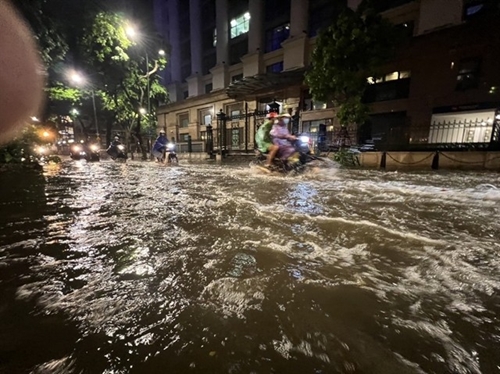The committee’s standing office sent the request to the steering committees for natural disaster prevention and control, search and rescue of the provinces and cities on June 9, after the northern region experienced experienced heavy rain over the past few days.
    |
 |
|
Prolonged heavy rain causes flooding on Tong Dan street in Hoan Kiem district of Hanoi. |
According to Hanoi Sewerage and Drainage One Member Co., Ltd., the city has been seeing widespread showers with an average rainfall of 30-80mm. This figure went up to 100-140mm in the districts of Hoang Mai, Long Bien and Thanh Tri.
Heavy rain caused flooding in several areas of the capital city from June 8 night to early June 9 morning, notably on the streets of Nguyen Van Cu, Truong Dinh and Phan Boi Chau - Ly Thuong Kiet intersection.
The Hanoi Sewerage and Drainage One Member Co., Ltd. is monitoring key pumping stations to lower the water level and ready their response in case of continuing showers.
Severe flooding was also recorded in the port city of Hai Phong and the provinces of Dien Bien and Quang Ninh early June 9 morning.
Rain-induced inundation in the coastal city of Hai Phong also coincided with high tides, resulting in the most severe flooding since the beginning of the rainy season.
In the mountainous parts of Dien Bien and Quang Ninh provinces, warnings have been issued for flash floods and landslides.
Heavy flooding also resulted in traffic congestion and crop damage in these localities.
The National Center for Hydro-Meteorological Forecasting said that the North would continue to see heavy rain, in some places torrential rain of up to 80mm and even up to 150mm.
The region might experience thunderstorms, tornadoes, lightning, hail and strong winds.
It also faces a risk of flash floods, landslides in mountainous areas and flooding in low-lying and urban areas.
To pro-actively respond and minimise damage, the national steering committee requested provinces and cities closely monitor warning and forecast bulletins and regularly notify and guide authorities and residents at all levels.
Localities must prepare on-site forces to assist people if necessary.
The Northern region should also deploy security forces to inspect and review residential areas along rivers, streams and low-lying areas with high risks of flooding, flash floods and landslides. They must relocate and evacuate people when needed.
Localities direct specialized agencies to coordinate with local television stations and other information and communication agencies, especially at a grassroots level, to educate and instruct people on how to cope with rain as well as thunderstorms accompanied by tornadoes, lightning, hail and strong winds.
A number of reference documents have been developed by the national steering committee and posted on the website phongchongthientai.mard.gov.vn/Pages/Tai-lieu-truyen-thong-pctt.aspx.
At the same time, provinces and cities are responsible for frequently and closely monitoring weather developments and natural disasters, summarizing reports and sending them to the National Steering Committee for Natural Disaster Prevention and Control.
Source: VNA